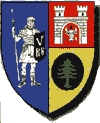|
Zlatna
Zlatna (German: Klein-Schlatten, Kleinschlatten, Goldenmarkt; Hungarian: Zalatna; Latin: Ampellum) is a town in Alba County, central Transylvania, Romania. It has a population of 6,652 (2021). AdministrationThe town administers eighteen villages: Botești (Golddorf; Botesbánya), Budeni (Higendorf), Dealu Roatei (Rotberg), Dobrot, Dumbrava, Feneș (Wildendorf; Fenes), Galați (Galz; Ompolygalac), Izvoru Ampoiului (Gross-Ompeil; Nagyompoly), Pârău Gruiului (Gruybach), Pătrângeni (Peters; Ompolykövesd ), Pirita (Pfirth), Podu lui Paul (Pauls), Runc (Goldrücken), Ruși (Rusch), Suseni (Oberdorf), Trâmpoiele (Trempojel; Kénesd), Valea Mică (Kleinwasser) and Vâltori (Waldrücken; Vultur). GeographyZlatna is located 36 km (22 mi) north-west of the county seat, Alba Iulia, on the border with Hunedoara County. Situated in the Zlatna depression, between the Metaliferi Mountains and the Trascău Mountains, the town lies at the confluence of the Ampoi River with Valea Morilor creek. History
A gold mining settlement has existed in the area since Roman times, when it was known as a municipium under the name of Ampellum. The name Zlatna (derived from the Slavic term for gold) was first recorded in a 1347 document. In 1387, it was awarded town status. During 1619-1620 Gabriel Bethlen, brought to Zlatna a few hundred German and Slovak settlers for mining work. Tellurium was first discovered in a Zlatna mine in 1782 by Austrian mineralogist Franz-Joseph Müller von Reichenstein. Zlatna regained its town status in 1968, after a time when it was officially a commune. At the 2011 census, 89.59% of inhabitants were Romanians, and 4.59% Roma. NativesClimateZlatna has a humid continental climate (Cfb in the Köppen climate classification).
Points of interest
References
|
|||||||||||||||||||||||||||||||||||||||||||||||||||||||||||||||||||||||||||||||||||||||||||||||||||||||||||||||||||||||||||||||||||||||||||||||||||||||||||||||








